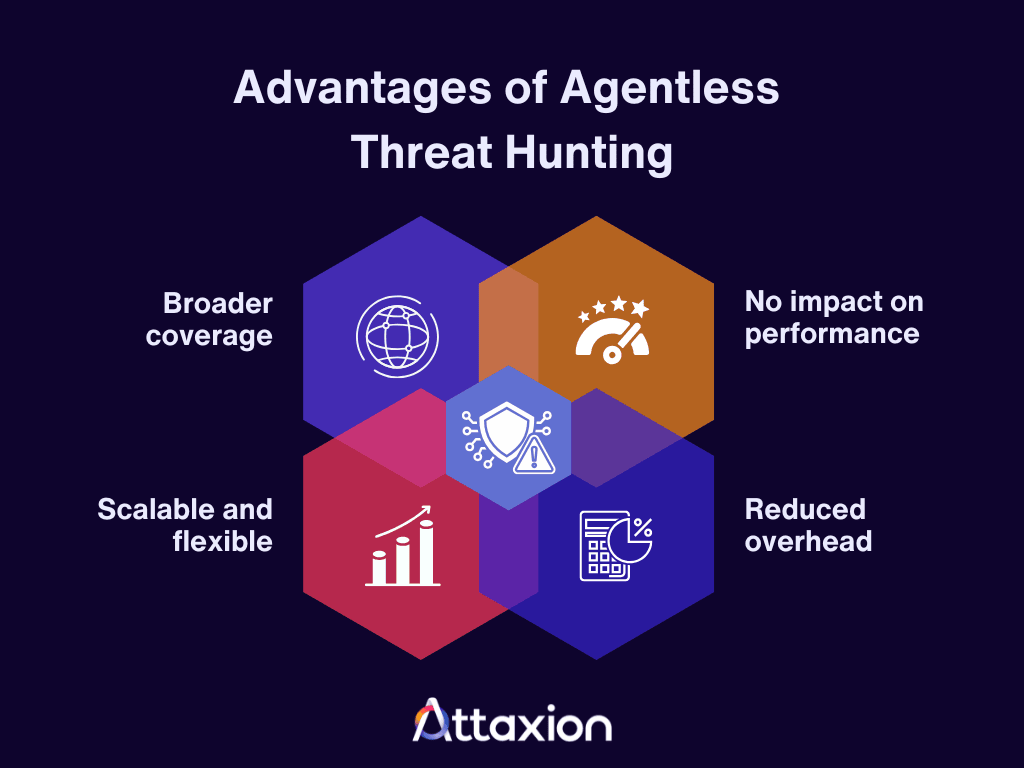Agentless threat hunting is a proactive cybersecurity approach that allows security teams to uncover malicious activities and cyber threats residing within a network without installing any separate agents directly on endpoint devices or servers. By “agents,” we mean software components running on the endpoint that can collect telemetry (processes, memory, file activity, registry, and more) and take actions such as quarantine, block, or kill processes.
Instead of using on-device software agents, agentless threat hunting (and other agentless security approaches as well) relies on non-intrusive methods to gain visibility over the network and detect malicious activities. These methods include network flow analysis, API integrations with cloud services (e.g., AWS, Microsoft Azure, and Google Cloud), system log inspection, and behavioral monitoring.
Agentless threat hunting is a security measure best suited for protecting complex environments, such as those containing unmanaged IoT devices or Bring Your Own Device (BYOD) endpoints, as it offers broad coverage and scalability while minimizing the operational burden associated with agent-based security tools.
Table of Contents
- How Agentless Threat Hunting Works
- Advantages of Agentless Threat Hunting
- Limitations of Agentless Threat Hunting
- Agentless vs. Agent-Based Threat Hunting
- How Attaxion Can Help
- Expert Tips on Agentless Threat Hunting
- Frequently Asked Questions about Agentless Security
Agentless Threat Hunting: A Deep Dive
How Agentless Threat Hunting Works
Here’s how agentless threat hunting works, from data collection to analysis.
Data Collection
Since there is no specialized security agent involved, agentless solutions gather the data they need through remote methods such as:
- Network traffic flow analysis: Agentless solutions inspect and monitor network flows by integrating with existing network equipment or analyzing NetFlow records, allowing them to collect traffic data, including who, where, when, and how much traffic is exported from routers and switches.
- Application Programming Interfaces (API) integrations: APIs enable agentless solutions to access data, security posture information, and logs from modern cloud environments and virtual machines. Accessing these logs via API provides records of every action taken — who logged in, what configuration was changed, and what resource was deployed.
- Log and configuration data collection: Data is gathered by directly fetching system logs that provide details about process execution, user activity, and service changes. This method also involves performing configuration scans from the source systems to gain insight into security policies, user group memberships, installed patches, and cloud environment configurations.
Data Analysis
Once data from the above methods and sources are aggregated, the following processes occur within threat detection tools:
- Behavioral analytics: The platform first builds a profile of normal activity for every user and asset based on historical log and flow data. For example, User A typically logs in between 8:00 AM and 6:00 PM from Region X and accesses Server Y. Device B normally communicates only with Domain C, using a standard volume of data.
- Anomaly identification: AI and machine learning algorithms are then used to identify significant deviations from the established baselines, focusing on large-scale, observable behaviors such as a sudden increase in failed login attempts across multiple user accounts (credential stuffing) or a server initiating a connection to an external IP address that has never been seen before.
- Threat detection: Agentless solutions tap into external threat intelligence (TI) to cross-reference aggregated logs and network flows. This query process checks for Indicators of Compromise (IOCs), such as known malicious IP addresses or hashes, that match historical and real-time data to determine if any internal system has ever interacted with them.
- Security risk prioritization and incident response: Advanced threat hunting tools correlate multiple low-fidelity events to detect a high-fidelity incident. For example, the tool might combine:
- A spike in failed logins (from identity logs).
- A lateral move attempt (from network flow data).
- An exposed cloud environment configuration (from a cloud API scan).
The detected activity is then mapped to the MITRE ATT&CK matrix to see if it matches known adversary behaviors. This mapping provides security teams with a standardized understanding of the severity and potential impact of the threat, enabling them to assess and prioritize the security risk and immediately implement the most effective remediation steps (e.g., revoking a specific set of credentials instead of just blocking an IP address).
Advantages of Agentless Threat Hunting

Broader coverage and flexibility
Agentless solutions offer broader coverage than agent-based ones. They can cover devices such as IoT and complex environments such as cloud workloads across various operating systems — where deploying or maintaining an agent is either impractical or impossible. That’s why the agentless approach to threat hunting allows security teams to scale their efforts across dynamic hybrid and multi-cloud infrastructures.
No performance impact and reduced overhead
Since there is no additional software running on the endpoint, the agentless security approach ensures zero performance overhead on end-user machines. No additional software also means fewer deployment issues and less ongoing maintenance or patch management. That, in turn, lowers provisioning costs and operational complexity.
Limitations of Agentless Threat Hunting
While the agentless security model has its benefits, it also has a few inherent limitations.
Lack of real-time visibility
Without deploying an agent on a system, it’s often hard to monitor live processes and network connections. Centralized log collection and correlation may be set up to happen regularly, but still not completely in real time. That’s why agentless threat hunting can potentially introduce a delay that impacts one of the important metrics that security teams use — MTTD (Mean Time To Detect).
Limited response capabilities
The security approach is also limited in its response capability, as it can’t implement security policies at a granular level. Without a deployed agent, you can discover the threat, but there’s less direct control over containment or remediation.
Agentless threat hunting is generally viewed as a complement to, rather than a replacement for, agent-based security solutions. It helps extend coverage, while agent-based security tools provide real-time visibility and more granular control for faster detection and response.
Agentless vs. Agent-Based Threat Hunting
The distinction between agentless and agent-based security threat hunting lies in where the intelligence is gathered and a few other aspects, as shown in the table below.
| Aspect | Agentless Threat Hunting | Agent-Based Threat Hunting |
| Data source | Remote logs, network flow, cloud APIs, configuration scans | Local operating system telemetry (processes, file system, memory, registry) collected by a dedicated sensor built into endpoint detection and response (EDR) or other agent. |
| Depth of visibility | Broad — excellent for network-level lateral movement, cloud misconfigurations, identity abuse, and high-level behavioral anomalies. | Granular — suitable for detecting host-level attacks, fileless malware, in-memory cyber threats, and local command execution. |
| Scope | Environments where software agents are impossible — IoT devices, legacy systems, network devices, and fast-changing cloud infrastructure. | Critical endpoints, servers, and systems where continuous forensic detail is mandatory. |
| Deployment and maintenance | No per-host software to install, update, or maintain. Low or no impact on system performance. | Requires installation, configuration management, and troubleshooting on every host. Can consume system resources. |
| Response capability | Passive/indirect incident response, such as revoking cloud API keys, changing security group configurations, or pushing firewall blocks. | Active/direct response, as it allows for immediate actions such as process termination, file quarantine, or network isolation of the host. |
How Attaxion Can Help
Attaxion offers the Agentless Traffic Monitoring feature that analyzes the network traffic flowing to and from the external IP addresses within an organization’s infrastructure. It does so without installing any software agents on the servers or on the network itself.
Using Netflow data and correlating it with threat intelligence, Attaxion’s agentless monitoring can reveal if any of the external IPs in your infrastructure communicate with IP addresses that are known to be malicious. For such communications, it provides you with details, such as the type of attack and, if available, the specific malware family associated with the external IP address.
This enables threat hunters to focus their attention on specific IP addresses and gives them a starting point for their investigations.
To extend coverage, Attaxion automatically discovers your external-facing IPs using a set of cyber reconnaissance techniques so that you get a full overview of your external attack surface and don’t accidentally overlook an IP that attackers might use. You can also connect Attaxion to your cloud environments to enable more efficient discovery, ensuring better coverage and visibility.
Expert Tips on Agentless Threat Hunting | |
| By Max Beatty, Security Expert and Head of Growth at Attaxion. Max has over 8 years of cybersecurity and consulting experience, having previously worked at SolarWinds and Brinqa. At Attaxion, he leads the growth efforts and helps customers enable exposure management in their organizations. | |
| Prioritize Risk Over Volume High volume of communications between your IPs and with a malicious IP doesn’t always mean higher risk, than a single connection to known command-and-control (C2) infrastructure. When looking at traffic logs, prioritize connections to C2 servers and communication with IPs tied to malware families and botnets. Pay Special Attention to Recently Added Assets If there was some shadow IT that you’ve recently discovered and brought to light, that infrastructure’s communications deserves special attention, as it was not properly managed before. Use Historical Traffic to Spot Past Compromise or Persistent Access In Attaxion, historical traffic data is available immediately after enabling the Agentless Traffic Monitoring feature. Use it to look back over the past 30 days for suspicious outbound communications. Found something? Track if the same IP has been communicating with multiple systems across your environment — a potential sign of persistent or widespread compromise. Use Your Data to Validate Firewall and Egress Rules NetFlow traffic logs can not only help find threats, but also what outbound traffic is actually allowed out of your network. Cross-check egress traffic against your firewall policy — what’s actually leaving your network may surprise you. | |
Schedule a free demo now to see how Attaxion’s Agentless Traffic Monitoring can support your threat hunting efforts.

